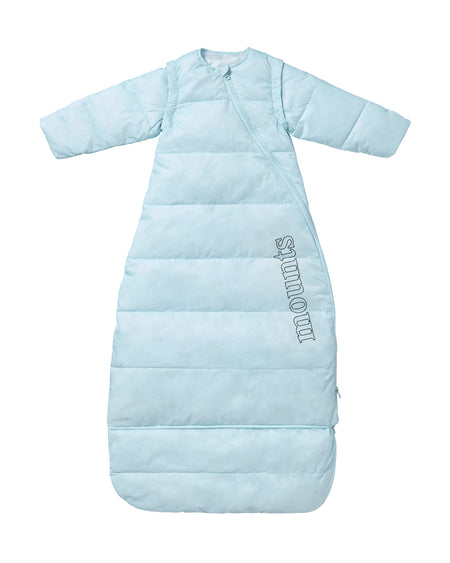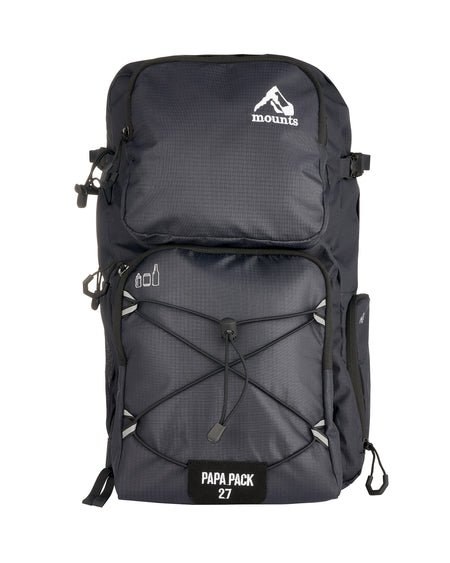How to Get Back On The Trail
August 15 2023 – Anne Brillet
If you’re reading this article, you’re probably more than familiar with the rollercoaster journey of caring for a new child! From the joys of first steps to the pain of sleepless nights; as your sprogglets develop, they will go through many phases and take you along for the ride.
Returning to the great outdoors is a super exciting part of that ride – and if you're well prepared, it doesn't need to be a headache.
When planning a family adventure, our advice is to take it slow and steady. Start with something easy like a half-day hike in the woods with your baby in a front carrier. Once you've gotten the hang of it, you can work your way up to longer camping trips with your toddler. It's all about building confidence and having fun along the way!
So, you've decided to go camping with your kids? Awesome! But before you head out, make sure you have a plan for pitch-up and key activities. From setting up the tent and unpacking your gear, to cooking dinner and gathering firewood, there's a lot to think about. Unlike at home, you'll need to plan where your kids will be during these activities to keep them safe. Trust us, trying to set up a tent while keeping an eye on your little ones is a recipe for stress and frustration. But with a bit of planning, you can make sure everyone has a great time and stays safe.
Children's phases and their needs
We see roughly five phases of a young child’s development and we will highlight needs, challenges and practicalities:
- Phase 1: Blob
- Phase 2: Potted plant
- Phase 3: Assisted walker
- Phase 4: Confident walker
- Phase 5: Independent walker
Each phase has its considerations and advantages. All children reach phases at different times, but in each phase, there is a route to starting to get back out on the trails.

Phase One - Blob
We know it might sound crazy, but hear us out: now might actually be the best time to hit the trails again. We get it, as a new parent you're probably running on fumes and even the thought of leaving the house might seem daunting. But think about it – your little one is likely sleeping in between feedings and can nap just about anywhere (bassinette, carrier, pram, bouncer, your arms, you name it!). Plus, they're still small enough to carry comfortably in your arms or a chest-mounted carrier. So why not give it a shot? Getting some fresh air and exercise can be a great way to recharge and boost your mood.
The advantages of Phase One are as follows:
- If you're breastfeeding, you don’t need to carry additional food or water. Only Mum needs to be present (though she may want feeding!).
- Both parents are available to carry full-sized backpacks (baby is carried on your chest) such as the Papapack.
- The baby is light, so it does not overburden the parents' ability to travel distances or carry additional weight.
- The baby will likely feel comfortable in its sleeping environment.
- The baby is likely unable to find trouble inside the tent or in the wilderness, making it easily monitored and contained.
Considerations for Phase One:
- The baby is fragile, so extra care must be taken.

Phase Two - Potted Plant
Once you hit phase 2 of parenting, things start to get easier. Your baby will settle into a night routine, allowing you to catch up on some much-needed rest. They might even start crawling or rolling around, which is super fun to watch. Your baby is becoming more adaptable to different sleeping environments, like the crib, carrier, pram, bouncer, your arms, and any other noisy or quiet spots. And, of course, they're still light enough to carry around without too much hassle. At six months, the walking carrier is still best worn on your chest. During this phase you’ll be experimenting with puréed food which is light and easy to carry with you.
Phase Two Advantages:
- Store-bought purée does not require refrigeration
- Both parents are available to carry full-sized backpacks (baby carried on chest).
- The baby is light, not overburdening the parent’s ability to travel distances or carry additional weight.
- The baby will likely have settled into a sleep routine and will be more predictable.
Phase Two Consideration:
- Baby formula needs sterilised water so bring sterilised water or buy ready-made bottles.
- If sleeping horizontally, baby will roll around frequently during sleep and will need containment.
- The baby can find dangerous items inside the tent. Items must be stored safely.
- Baby is still fragile and extra care must be taken.

Phase Three - Assisted Walker
By the time you hit phase 3, you'll be feeling pretty good about your baby's routine and what makes them happy or not. You'll also be a pro at taking care of your little one while you're out and about. Your baby will be crawling around and getting the hang of standing up with some help. They'll be chomping down on solid foods, drinking whole milk and water. They'll be taking two naps a day in all sorts of different places - a crib, stroller, you name it. And at night, they'll be snoozing away in a cosy crib in a dark room. They'll have graduated to a backpack-style carrier and will be starting to get a bit heavier, making it harder to tote them around for long periods, with extra weight for camping stuff.
Phase Three Advantages:
- Baby is still light enough to carry on your back.
- Baby doesn’t want to walk independently.
- Baby is starting to recognise surroundings and engage by pointing.
Phase Three Considerations:
- You need a quality backpack carrier for your child. This reduces the amount of packing space available and may hinder the distance you can travel, particularly uphill.
- The baby is actively moving around and needs active monitoring during the day.
- For sleep, they are starting to move more frequently. They need a contained space for warmth and safety.
- If they wake before you do, they need to be in a safe environment clean of loose gear with all dangerous items stored securely.
- A travel crib may be necessary, but these can be bulky and heavy.
- Milk and perishable solid food needs to be carried and stored correctly.

Phase Four - Confident Walker
Just a heads up, Phase 4 of hiking with your toddler might be a bit of a challenge. Your little one is getting more active but also will get tired quickly, so you'll need a backpack carrier since they're too heavy to carry in your arms for long distances. They'll be down to one nap a day and have a set bedtime routine. Oh, and don't forget they need to sleep in the dark now! It's essential to keep them entertained on the trail too, or they'll get bored pretty quickly. However, as they start speaking, it’s a delightful time as they start naming things around them, such as trees, birds, and leaves. This is the perfect time to start inventing stories about wood fairies!
Phase Four Advantages:
- The toddler is starting to become aware of potential dangers and may be slightly more independent.
- Toddlers will be able to eat simple adult food so everyone can eat the same thing without special prep.
- Your toddler will truly engage with their surroundings and enjoy the great outdoors. Make it fun!
- First memories are made so you are genuinely influencing their likes and dislikes for the future.
Phase Four Considerations:
- A quality backpack carrier is necessary, but toddlers will walk to walk independently as much as possible. This means they can veer off track, and covering distance will take extra time.
- Toddlers can move more independently, and this includes sleep, so you might need a travel crib depending on your child, and these can be heavy and bulky.
- Your toddler will likely still have evening milk, which needs to be stored adequately (you can find mini long life).
- If you are camping around a fire, it is essential to teach your child the dangers of it. Additionally, any water sources nearby will need to be monitored.
Phase Five - Independent Walker
The challenges of hiking and camping with young children start to improve when you reach Phase 5. At this stage, your child is becoming accustomed to walking distances unassisted, but be mindful that they will get tired quicker than adults and will be heavy to carry. Outdoor activities become more straightforward as they start to listen to your directions and warnings and become more engaged with each activity making it more fun for all! They might start to drop the day nap, allowing you to take advantage of the entire day. Bedtime is more manageable, and timing can be more flexible so they can enjoy a couple of s'mores by the campfire.
Phase Five Advantages:
- The child is becoming aware of potential dangers and may need less monitoring.
- Milk may be less critical and can be removed from a short-term diet.
- The child can walk independently, giving back the parent’s ability to carry a full-sized backpack.
- A travel crib may no longer be necessary.
- Children will enjoy being involved in the planning of your trip, and this is a perfect time for some gamification of your outdoor adventure (think Geocaching, looking for fairies, collecting leaves).
- Children will enjoy having their own kit, so bringing their own backpacks or binoculars will be super fun for them.
- Children will walk further but tire quicker than adults so plan adaptable distances.
- Outdoor dangers are still present, so you must monitor potential hazards.
If you have found this article interesting, don't hesitate to share it as it helps us spread the word out there. Any questions, don't hesitate to email us or reach out on social media.




